SCIENCE BEHIND FAT LOSS
Let's talk about fat, how to gain and how to lose it!
Confusion around the basics of our biology causes the vast majority of consumers to believe in nonsense blog articles (no not me!), poorly written books and even scientists with agendas. Science is objective; there is no debate or ethics, there Is merely input, output and the conditions along the way.
This blog post will articulate in plain English what fat is, how we get fat, how our bodies remove fat and the most productive way to decrease your fat percentage. What I will not be talking about is what to eat, which macros or even a good old fat shame.
What is Fat

Call it blubber, fat or my big bones. All that soft stuff sitting around your body is known as adipose tissue (fat), mainly making up between 6-40% of someone's body. Humans have fat around their organs, bone marrow and just beneath their skin. There are two type of fat:
- Brown adipose tissue which when burnt generates heat and
- White adipose tissue which stores energy.
How do we Get Fat
 It all starts with that freshly cooked pizza, that steak sandwich or even that apple? Our bodies are amazing at eating a wide range of foods. Those foods start their process of digestion from when you cook them (heat), then chew them (saliva) and finally when they are broken down fully in the stomach (it also cleans your food for you). Once your food leaves your stomach, it makes it way down your small intestine where the magic begins!
It all starts with that freshly cooked pizza, that steak sandwich or even that apple? Our bodies are amazing at eating a wide range of foods. Those foods start their process of digestion from when you cook them (heat), then chew them (saliva) and finally when they are broken down fully in the stomach (it also cleans your food for you). Once your food leaves your stomach, it makes it way down your small intestine where the magic begins!
Most whole foods contain all Macronutrients (Carbs, Fats and Proteins) and a lot of Micros (too many to list). So that pizza you ate after it’s broken down will enter your small intestine and be naturally split off in to:
- Carbohydrates – helped by pancreatic amylase and further broken down from complex carbs into simple (fructose and glucose)
- Fibre carries onto the large intestine
- Fats – with the help of lipase and bile, broken down into fatty acids
- Fat carries onto the Large Intestine with Fibre
- Proteins – Using proteases pushes the proteins to be broken down into amino acids
Let's ignore micros/glucose/fructose and amino acids for now.
Our fibre and fatty acids go into the large intestine where some bacteria has a field day with your fibre (without it… bacterial overgrowth anyone?) and the remaining fibre helps to transport excess Cholesterol from your body. Why is the protein cholesterol there? It is here to grab that amazing fat and whizz it around your body as the body doesn’t want to waste any fat! Any excess cholesterol is bonded to the fibre and taken out the back door.
The fatty acids then bind to the cholesterol and are whizzed around the body to where they are needed, but when there are too many fatty acids the body will store them as adipose tissue.
Glucose and Fructose both leave the small intestine and head to the liver where Fructose can be made into glycogen and glucose heads around the body as it can be made into energy anywhere in the body. This system allows the body to have the direct energy to the cells that need it when they need it, but too much glucose can be dangerous, which triggers the body to release a hormone called Insulin.
Insulin tells cells the cells to absorb glucose, fatty acids and amino acids. Once in the cells, the cells will store the fatty acids aka creating more adipose tissue and will also fill up your muscle cells to have a “store” of glucose ready to use. Another useful fact is to remember that insulin and cortisol and a few other bits and bobs have timings. you have your highest levels of cortisol in the morning for instance and your body doesn't want any insulin towards the time you sleep! To reward you for that late dinner close to bed time, it will store the majority as fat :)
However, if the cell can not store any more glucose, then It will transform this into Fatty Acids to store for the long term through fatty acid synthesis.
Fatty Acid Synthesis isn’t very effective; there have been inconclusive studies, so let's not get caught up in the percentage, but just know it costs you energy to store this energy.
Just to add to the thought process…. Amino acids that are not used up in this process will become glucose and then become fatty acids as well.
Just to clarify the above:
- Food turns into
- Carbs either
- Complex (Starch) turns into Glucose
- Fructose in the liver turns into Glycogen (Fructolysis)
- Glycogen into Glucose into (Glycolysis)
- Glucose turns into either
- Acetyl-CoA aka energy (Glycolysis)
- Fatty Acids (Fatty acid metabolism)
- Glucose turns into either
- Fats turn Fatty acids and either
- Stored Fatty acid synthesis)
- Acetyl-CoA aka energy (Fatty Acid Oxidation)
- Used around the body like the heart as a fuel source
- Proteins turn into amino acids than either
- Used for repair
- Transferred to Pyruvate to follow the glucose process but with nitrogen entering the body
- Acetyl-CoA aka energy (deamination α-ketoacids)
- Fatty Acids
- Carbs either
If you consume too many macronutrients, your body will not waste them, and the laws of thermodynamics do prevail... you will store more white adipose tissue.
Energy
Better known as acetyl-CoA, the energy chemical that all animals use to power their cells and therefore their body. A brief overview of acetyl-CoA and the cycle in which all macronutrients partake is good for context sake. Once acetyl-CoA is produced in the cell, it enters through what is called the Krebs cycle and is oxidised (aka oxygen binds), and this produces CO2 + energy for the cell. You then push out the CO2 through exhaling. So no…. you don’t excrete fat or sweat it out. Whatever you eat is transformed into energy and the fumes are CO2… much like a lot of combustion engines.
Once acetyl-CoA is produced in the cell, it enters through what is called the Krebs cycle and is oxidised (aka oxygen binds), and this produces CO2 + energy for the cell. You then push out the CO2 through exhaling. So no…. you don’t excrete fat or sweat it out. Whatever you eat is transformed into energy and the fumes are CO2… much like a lot of combustion engines.
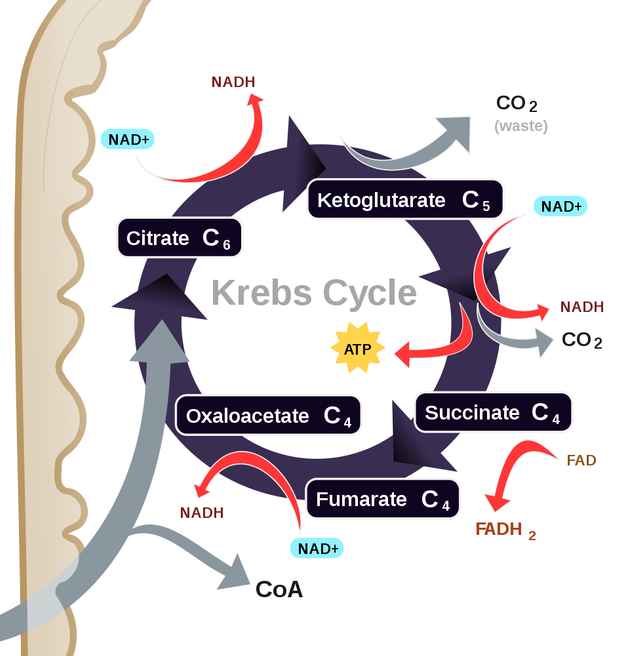 The Citric Acid and oxygen combustion is used for all breathing animals. This doesn’t mean that we need oxygen to move. We can for a short time use glucose straight (this produces lactic acid) and also we can use Creatine to form ATP while there is no oxygen. These are used in either the start of moving where you are moving before your body realises or when your breathing cannot catch up with your workout. Creatine and Direct Glucose are out of scope for this article, thou they have some interesting effects on fat gain if you are a heavy runner or bodybuilder.
The Citric Acid and oxygen combustion is used for all breathing animals. This doesn’t mean that we need oxygen to move. We can for a short time use glucose straight (this produces lactic acid) and also we can use Creatine to form ATP while there is no oxygen. These are used in either the start of moving where you are moving before your body realises or when your breathing cannot catch up with your workout. Creatine and Direct Glucose are out of scope for this article, thou they have some interesting effects on fat gain if you are a heavy runner or bodybuilder.
Using Glycogen for Energy

Three processes are involved
- Glycolysis of glucose to two pyruvate molecules
- Pruvate oxidation to acetyl-CoA
- Oxidation of acetyl-CoA to CO2in the citric acid cycle•
- Energy stored from oxidation of one molecule of glucose = 36 ATP after all reduced coenzymes are oxidised•
- Fatty acid synthesis from acetyl CoA takes place in the cytosol for unused Glucose
Using Fat as Energy
As we have probably learnt by now.. the laws of thermodynamics and chemistry are not lying to you. There is no product to buy or elite secret to fat gain and therefore fat loss. You gain fat from the fat you eat that isn’t used as repair, by excess carbs and protein and this is all driven by that lovely hormone Insulin.
Insulin hormone gets a lot of bad feedback, but we do need it to regulate glucose in the blood, OR WE DIE. There are slight excuses for getting fat faster… if you eat foods that disagree with you and spike your insulin… this will drive more fat/carbs into your cells, and they will be forced to store as white fat then you will still feel you need more glucose later in the day… thus your slow get fatter. End of the day it is you over consuming and not the food choices fault.
End of the day it is YOU that is OVER consumingWe can also say … if I don’t eat carbs, there will be no insulin and therefore no fat. Although partially true, you will still produce some insulin, and excess protein will turn to glucose, and excess fat just may still get stored… although a good ketosis diet will mean you will just use or urinate your excess it is not a diet for everyone and being in 24/7 ketosis isn't the defining factor which is what we will get to.
So lets talk about how to get rid of that fat? If insulin is the hormone that tells cells to store then how do we tell the cells to release the fat? That’s the aim here, release the fat, i.e. your cells need to remove the white stores of fat and do something with them. Preferably use as energy as your body hates to waste anything. Any idea?
Glucagon! This hormone is the opposite of insulin and CAN ONLY be in the system if the insulin is not. This is a key thing to remember.
So when Insulin is no longer needed, aka the blood sugar levels are below the bodies idea of safe, glucagon is produced by the pancreas to tell the cells to release energy. First, it ensures that the glucose is used and once there is no more glucose (without exercise) the glucagon hormone second jobs is to tell the cells to move onto the next energy source which is our long-term white fat tissue.
The fatty acids are released into the blood, whizzed back around the body to the liver, and then the liver will start transforming those fatty acids into Ketones!
So just to recap…

- Body has low insulin
- Pancreas produces glucagon
- Cells release white fatty acids
- Fatty Acids go to liver and get pumped out as
- Acetoacetate
- Beta-hydroxybutyrate,
- Acetone
Does this mean I should see ketones in my urine? No… you want to be using them for energy. Ketone sticks are great to know if you are in ketosis but they show an excess amount of ketones and not that you are producing (unless you use a blood ketone monitor). So to lose weight, you DO have to produce ketones, you DO NOT have to find them on your pee stick.
A fun bit of info. All cells in the body apart from red blood cells can use ketones for energy as they are utilized in the mitochondria of the cell (red blood cells have no mitochondria) and now ketones have shown to move over the blood-brain barrier. This makes logical sense from an evolutionary standpoint of months of starvation 😊
In all other tissues, the fatty acids that enter the metabolising cells are combined with coenzyme A to form acyl-CoA chains. These are transferred into the mitochondria of the cells, where they are broken down into acetyl-CoA units by a sequence of reactions known as β-oxidation. The acetyl-CoA produced by β-oxidation enters the citric acid cycle in the mitochondrion by combining with oxaloacetate to form citrate. This results in the complete combustion of the acetyl group of acetyl-CoA (see diagram above, on the right) to CO2 and water. The energy released in this process is captured in the form of 1 GTP and 11 ATP molecules per acetyl group oxidized. This is the fate of acetyl-CoA wherever β-oxidation of fatty acids occurs.
For the numbers people:
~ 12 ketones on av per fatty acid
Therefore ~ 129 ATP per fatty acid
You can see that if glucose is 36 how we get a rough understanding of “calories” basing it on a unit of energy (although this does show fat is 4x more energy rather than conventional understanding o nine cals for fat and 4 for net carbs. I’ll just quickly do some math…
o acetoacetate is ATP of 33 net
o β-OH butyrate of ATP is 21
o I can not find how many fatty acids there are in the likes of acylglycerols, but we must assume 2.2. Let's carry on.
Why would your body use fat?
We have spoken about HOW the body uses fat, but let's talk about WHY? The bodies main drive is to survive; it does this by having a constant supply of energy for you and your brain to ensure survival. Selfish a? With that in mind it will use whatever you give it to fuel your body and no matter how many ketosis peeps that are out there, this will normally mean Carbs first for most activities.
When the body runs out of carbs, or it presumes it will run out of carbs….. this will make the body start to generate ketones as long as two conditions are met
There is low to no insulin
The liver isn’t busy with fructose (yes runners)
So let's talk about running out of carbs. The body only has enough fuel for around 16-30 hours of activity (
80% stored in muscles and 14% in the liver and 6% in the blood), around 300-400g carbs at a max.
This means we can just stop eating 😊 Yes good old fasting. Within 48 hours, you will 100% know your bodies glucose has been depleted. You can also eat fewer carbs then you need every day and you will slowly run out of carbs as well, a sort of carb restriction diet. Lastly there is long term exercise like walking or generally getting off of your bum (as I write this at my desk). As your body does not know when you are planning to stop and you haven’t eaten for a few hours, your body has to assume this may continue and will be forced to produce ketones to save the precious glucose for when you need it… like running from that possum.
This does give you three specific options to lose fat. Fasting, calorie restriction and long stable exercise. Lets be clear, you WILL NOT lose body fat if your body has always got a high level of insulin, your body WILL NOT lose body fat if you eat MORE energy than your body requires in a day AND you WILL NOT lose body fat sitting at a desk all day eating high carb food MORE THAN you need every day.
Bodyfat Percentage
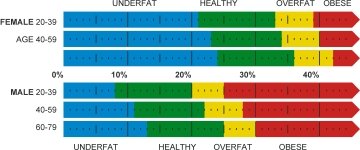 As we said earlier the human body can have a huge range from the tiny single digits of percentage body fat to quite insane numbers. Your body is the products of your actions.
As we said earlier the human body can have a huge range from the tiny single digits of percentage body fat to quite insane numbers. Your body is the products of your actions.
A healthy female and a healthy male have quite different body-fat percentages and that is due to our differences in sex and where each sex holds fat. It is quite common for body fat between 18-25% to be aesthetically pleasing for females and 8-14% for males.
So if body fat is a key factor in all cause mortality, the potential social constraints and it is genuinely uncomfortable to be fat... why do people focus so much on WEIGHT and SIZE instead of BODY FAT!
With our requirements for a healthy life are revolved around fat percentage, then it seems common sense to either maintain muscle or increase it and reduce body fat.
Our wins for a eating plan would be to at least maintain muscle mass and drop fat from your body, we shouldn't concern ourselves with water weight, bowel weight or uncontrollable bone mass. To measure your body-fat is a blog by itself, but either use calipers or a tape measure so you can do this weekly on the same day/time and ensure your body-fat is going down.
With body-fat it is always good to have a plan so you can work backwards to step forward. So let us use a basic example. Joe weighs 85kg and has calculated 25% bodyfat and he wants to be 12% for a good athletic look.
85kg * 0.25 = 21.25kg of fat and 63.75 of Lean Body Mass (LBM)
63.75 / (1-12%) or 63.75 / 0.88 = 72.44kg. This is our end weight if we were to lose nothing but fat.
85-72.44 = 12.55kg to lose. Each fat kg contains 7700 calories and therefore Joe needs to have a net deficient of 96'635
Losing Muscle
Why would we lose muscle? As we said earlier, our bodies are amazing, they will consume mostly anything and transfer macros and micros to where they are most needed to firstly keep you alive and then medium/long term health. With this in mind there are two reasons your body with cannibalise your muscle mass when it is in your best interests.
- Body will break down muscle if it is not being used
- This one can sometimes annoy some people *cough* bodybuilders *cough* but when you think of the energy requirements it takes to maintain muscle mass.... it is not worth keeping if it isn't required
- Body breaks down muscle tissue for glucose
- when your body starts to runs out of glucose from food and reserves, it turns initially to muscle to fuel your body, this is normally displaced by up to 1600% increase in growth hormone for those that fast 16-18 hours and most importantly it is shown to be the amino acids from areas you are not using; constantly running out of glucose and re feeding incorrectly, could mean a constant cycle of muscle loss / fat loss / fat gain

As you can see in the picture to your right, Gluconeogenesis (muscle cannibalism) starts the moment your bodies glucose levels start to decrease (around 4 hours) and peaks when glucose runs out entirely. To put it into context, your body needs time to transfer over to ketones and in that time it must fuel it with glucose and that will come from your muscle mass and vital organs.
With a bit of research you can assume up to 70grams of muscle mass in the first day with decreasing amounts for days after, averaging
- 50grams a day week 1
- 25grams a day week 2
- 15grams a day week 3
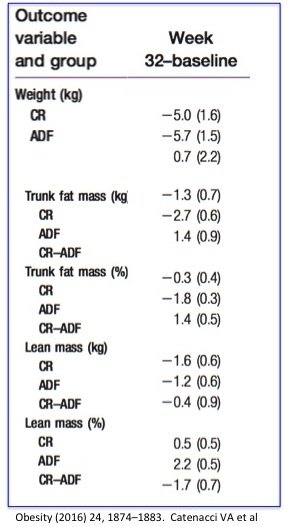 This really comes to light in the following study: Comparing directly a 400 calorie restriction with fasting for 24 hours every other day. This study was using the same amount of calories and surprise surprise... both groups lost the same amount of weight
This really comes to light in the following study: Comparing directly a 400 calorie restriction with fasting for 24 hours every other day. This study was using the same amount of calories and surprise surprise... both groups lost the same amount of weight
The truncal fat loss, which reflects the more dangerous visceral fat, was almost twice as good with fasting as opposed to calorie restriction. In fat mass %, there is almost 6 times! the amount of loss of fat during fasting.
As for muscle loss? As per common sense we would believe that the diet recommended for years to eat 400 calories less while "cutting" should come up trumps? Not for a long shot.
Presumably due to additional growth hormone, the fasting group actually INCREASED muscle while decreasing fat (2.2% increase). While the body will consume amino acids, it will also build new muscle much easier with additional hormones, resistance training and sufficient protein. To me this study is clean cut that muscle loss at the 24 hour period with sufficient resistance training will mean the preservation of muscle mass while the calorie restrictive diet will end in the same weight loss, however, a larger amount of muscle loss, insulin sensitivity, higher hunger hormones and metabolic damage.
There are two key things to remember here.
- That muscle mass is being converted into glucose so that your body can use as a fuel and thus if your body was already in ketosis, this wouldn't be required.
- Your body is using muscle mass you are not using to transfer into amino acids and then into glucose and it is not taking required muscles for whatever you do during your day (another reason why really big people who fast do not have the "wings" after). Interesting enough the larger you are, the less likely you are to lose muscle mass HERE
Energy Output
We have spoken a lot about energy input, aka the calorie and we touched the surface on what makes up calorie output in terms of muscle mass. Our basal metabolic rate is the amount of energy measured in kilo calories that we need to just sit there and live this is around 1200+ calories and is based upon your body mass. There are many things that influence this but that has to be out of scope of this blog post.
If we assume that a natural output for Joe is 2k calories a day. I.E if his body receives 2k kilo calories it will have enough energy to fuel his body for the day (we will ignore the fact that protein isn't meant to be used for energy). Any additional movement that Joe does will increase this 2k figure, so for this example so far.... Joe will be in bed all day.
What could cause Joes metabolic rate to drop? I have heard many times that if you fast even for 4 hours.... your metabolic rate will plummet and you will still put on weight. It is fear mongering but one that is fun to show incorrect.
A few facts to remember, continuous calorie restriction lowers metaboic rate over time (13% when 30% under calories) more then feed and fast. Fasting doesn't cause metabolic drop until minimum 60 hours ( lowers 8%) HERE In fact metabolic rate increases up to that time Mansell PI, et al. This makes sense from an evolution point of view, if we haven't found food in 5 hours and we suddenly have no energy? I think our species wouldn't have lasted as long as it did :)
So our only fear is not if our metabolic rate would go down (because that will always happen) but if it will stay down? The Biggest Loser has some of the greatest data on metabolic rate decreases
Over six months, their basal metabolism dropped by an average of 789 calories. Simply stated, they burning 789 calories less per day every day.All of this is completely predictable. This metabolic slowdown has been scientifically proven for over 50 years. In the 1950s Dr. Ancel Key’s famous Minnesota Starvation Study placed volunteers on a ‘semi-starvation’ diet of 1500 calories per day. This represented a 30% caloric reduction from their previous diet. In response, their basal metabolic rate dropped about 30%. They felt cold, tired, and hungry. When they resumed their typical diet, all their weight came right back.
Studies have directly compared daily caloric restriction with intermittent fasting, while keeping weekly calorie intake similar. A 30% fat, Mediterranean style diet with constant daily caloric restriction was compared to the same diet with severe restriction of calories on two days of the week.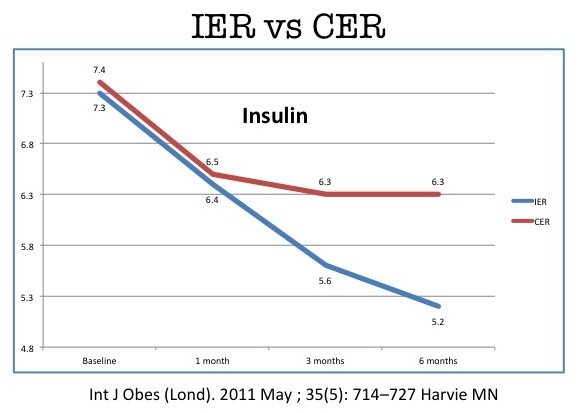
Over six months, weight and body fat loss did not differ. But there were important hormonal differences between the two strategies. Insulin levels, the key driver of insulin resistance and obesity in the longer term, was initially reduced on a calorie restriction but soon plateaued. However, during intermittent fasting, insulin levels continued to drop significantly. This leads to improved insulin sensitivity with fasting only, despite similar total caloric intake. Since type 2 diabetes is a disease of hyperinsulinemia and insulin resistance, the intermittent fasting strategy will succeed where caloric restriction will not. It is the intermittency of the diet that makes it effective.
Our study earlier to determine muscle loss in fasting/calorie restriction is back to help us with metabolic rate. What
happened to basal metabolism? If you look at the change in Resting Metabolic Rate (RMR). Using calorie restriction, basal metabolism dropped by 76 calories per day. 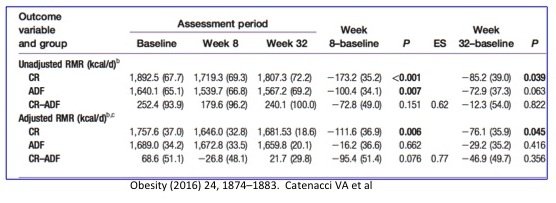
Using fasting, it only dropped 29 calories per day. In other words, daily caloric reduction causes almost 2 1/2 times as much metabolic slowdown as fasting! So much for that old ‘Fasting puts you into starvation mode’.
Weight regain differed during fasting vs calorie restriction. The fasting group leaned towards gaining more lean mass and continued to lose fat, while calorie restriction group gained both fat and lean mass. Part of the issue was that the fasting group reported that they often continued to fast even after the study was done. This is a no brainer due to how easy it is to fast once you get your head around it.
This leads us to some great info:
- Your body after 60 hours of reduced calories will lower metabolic rate to help
- You will lose muscle mass each time you start to run out of glucose (the only science I have ever seen to "stoke" the fire by eating every 3 hours)
- Actual Starvation (pop culture term) has less effect on metabolic rate decreasing then calorie restriction
- Your metabolic rate will increase again over time
- however, if you calorie restrict your insulin will spike and tell your body to put on weight FASTER! So buyer beware
- Your metabolic rate will not decrease if you fast less than 3 days at a time
Most Productive way to lose fat
It depends... I know what a cope out! However, it really does depend. Lets finish Joes example above. Joe is a big guy, not huge but still big at 25% body fat. He doesn't have a great deal of muscle mass either and he wants to get lean ASAP (dont we all). Joes requirements:- Retain high amount of muscle mass
- loose 12.5kg ASAP
- Willing to do any workouts or diet plan
Joe requires 2k calories plus a further 500 from his activities, thus 2.5k cal a day on average. If Joe was a lot larger, we would focus on a continuous prolonged fast with protein supplementation but to lose only 12.5kg of fat we will work on eating 10 hours out of 48. I.E 10 hours on, 38 hours off. In that 10 hours Joe will be consuming enough protein for two days (1.8g per lean kg) so therefore 134g x 2 = 268g in a day. This is based on the theory that your body will fully utilize the protein over the entire two days due to your body being stressed into needing to adapt quickly, much like the below study athletes.
Protein needs for energy-restricted resistance-trained athletes are likely 2.3-3.1g/kg of FFM scaled upwards with severity of caloric restriction and leanness. (HERE)Carb requirements should be low insulin producing carbs and this may require Joe to do some blood glucose testing, carb requirement is only to ensure the body has minimal amount of carbs for both two day periods. i.e 50g x 2 = 100g. Fat will make the surplus to our equation, Joe needs to decide what food is is happy to consume but should look towards eating 2.5k minimal in this 10 hour period.
Joes Plan
- 10k Steps a day
- Resistance training focusing on large compound movements
- 2500 kcal in a 10 hour period every other day
- 268g Protein
- 100g Slow Release Carbs
- 114g Fat
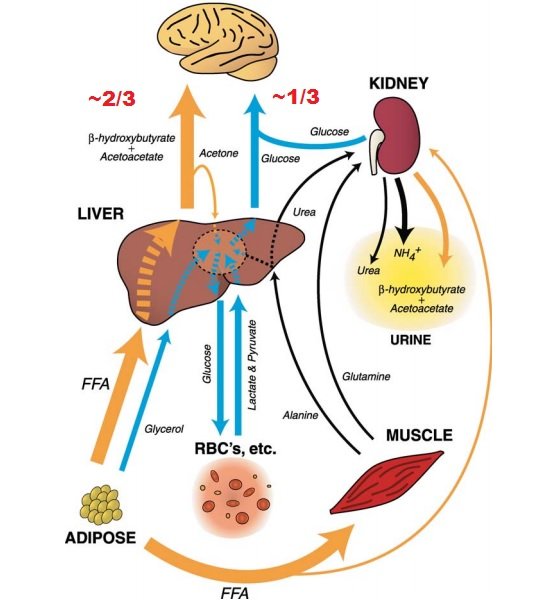
As I said earlier, if Joe was 30-40% body fat as a male, I would recommend multiple long term 10-21 day water fasts, yes you are sacrificing muscle mass but if you are this big you need to focus on your overall health and not muscle mass. As someone who has completed multiple week plus water fasts, this muscle loss is not noticeable even without resistance training. With only 1.8kg of muscle loss showing in this study with resistance training, you can see how the high end (5kg) to the low end (1.8kg) differs dramatically but when your metabolic rate only decreases by 13% but you loose 5.5kg of pure fat every 21 day water fast for a total net weight difference of 7.3kg. There is also more studies like HERE that are showing that protein amino acids like BCAAs can give your body enough push to make it negligible. I await further studies but for next fast I shall do 1.3 grams of protein per kilogram of my "ideal body weight",
I also don't want to get into the ins and outs of positive celluar level attributes to fasting as this blog isn't designed for this but with doctor supervision, some electrolytes you will be healthier for the fast and come out with a lot less bodyfat. For the larger male or female, the total water fast is the best option, where preserving muscle mass isn't as important as ridding excess fat tissue.
Variables between the two above diets can be changed up to meet your needs. For instance the body builder may only want to water fast once per week or 16 hours a day. It all depends on your goals. I for one only eat in a 10 hour window every day, ensure I get my 10k steps and then eat for my goals for the week.
When you compare these diets against the Eat Less, Move More that is a constant American fulled diet program that even is in the show The Biggest Loser and has some great short term weight loss (like our calorie restrictive diets above) but the metabolic rate had drops so much and the lack of understanding in diet meant bad long term effects for the shows competitors. what makes good ratings... doesn't mean great health.
"The average weight loss that season was 127 pounds over 6 months. Does it work long-term? Season two’s contestant Suzanne Mendonca said it best when she stated that there is never a reunion show because “We’re all fat again”."
In Conclusion
Mikes Law went a little deeper than he first thought (I originally was writing a why it's good to walk to burn fat), two weeks later, I hope I have given some value. There are plenty of things you can do to lose weight, cold showers, sleeping naked, drink cold water, eating weird herbs but they are all minor in the grand scheme of our bodies. Burning 1k calories in an hour run is GREAT! However, if you go off to the pub after it doesn't make any difference. Our bodies require a energy deficit as per thermodynamics but how you do that deficit will determine if you can mentally complete the task or have any long term effects from muscle wastage, metabolic damage or just a good old deficiency.If I could recommend anything to everyone, its to eat in a 12 hour or less window as per Dr Pandas research on all cause mortality, eat micro nutrients fist and then only eat the non insulin spiking carbs (get a glucose monitor and see what makes u tick), only eat enough carbs for the days activity you are doing and if that means sitting on the sofa all day? 50g and if it means two hours of pain in the gym or track? 200g, this is inline with not promoting excess insulin response or IGF1 that promotes inflammation and cancer (telling it to grow).
For your protein needs, the mTor pathway is also another cancer signal (giving it aminos to grow) but also excess protein becomes glucose via gluconeogenesis hence causing more inflammation. Therefore 1g per kg to 1.8g dependent on what you are up to on the day.
Once you have worked out Micro nutrients, Carbs and Protein, which should be lots of greens, veg and a few nuts. Eat the rest in fat; how much fat? Let your body decide. You will naturally eat the right amount if you stick to 75% of your volume in non starch veg but if you are paranoid, then crack out the calculator and look to eat your maintenance calories while doing some additional exercise. The fasting, walking, resistance training and carb limitation will do most of the work but the cardio will give you some great fitness for when you are carrying less weight.

wut? Go vegan.
Vegan is a lot easier. Included with the above